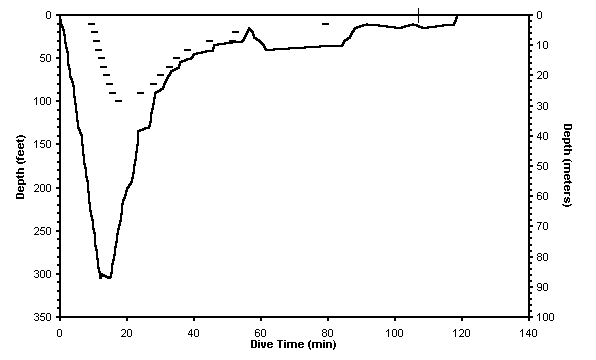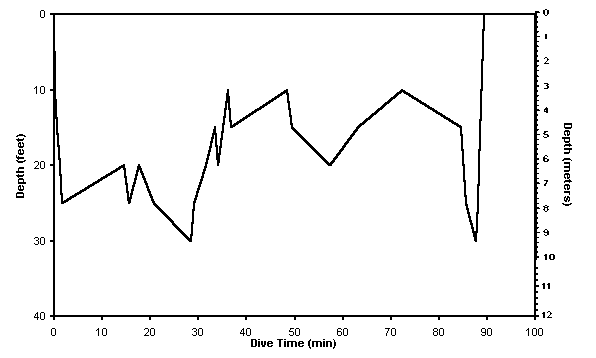Daily Log Report for
17
May 1997
Submitted by Richard Pyle
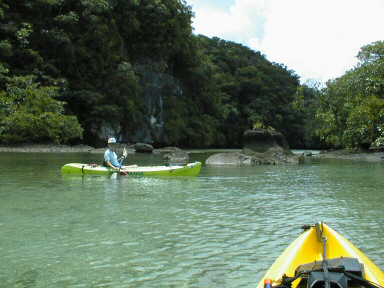 Lisa and I decided to
take the morning off and enjoy our beautiful surroundings
in Palau. We borrowed two kayaks from Pat & Lori
Colin, and Pat drove us out to some nearby Rock Islands
where he dropped us off. Lisa and I paddled across the
mirror-flat water, hearing only "jungle noises"
from various birds and insects. For all we could tell, we
were the only two people for hundreds of miles. As we
casually glided through the twists and turns between
islands, wandering deeper and deeper into the jungle, the
scene had all the feel of an Amazonian jungle.
Lisa and I decided to
take the morning off and enjoy our beautiful surroundings
in Palau. We borrowed two kayaks from Pat & Lori
Colin, and Pat drove us out to some nearby Rock Islands
where he dropped us off. Lisa and I paddled across the
mirror-flat water, hearing only "jungle noises"
from various birds and insects. For all we could tell, we
were the only two people for hundreds of miles. As we
casually glided through the twists and turns between
islands, wandering deeper and deeper into the jungle, the
scene had all the feel of an Amazonian jungle.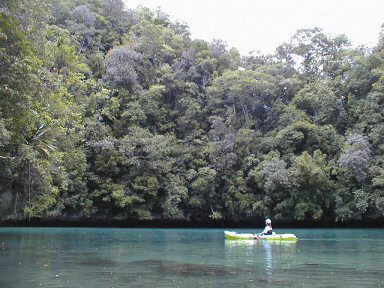 The difference, of course, was
that instead of muddy brown freshwater beneath the hulls
of our kayaks, there was crystal-clear saltwater complete
with lush coral reefs and a wide diversity of colorful
fishes. At one point during our paddling excursion, deep
in the heart of the labyrinth of canals and pools, there
was some violent thrashing in the water on the far side
of a small lake. At first we suspected that it might be a
saltwater crocodile attacking some helpless animal, but
as we got closer, we saw that it was a group of blue
trevally (Caranx melampygus) attacking a school
of small bait fish. After paddling for a while, we got
out our snorkeling gear and swam about with the video
camera, looking at the range of marine life. The entire
morning was incredibly relaxing and refreshing, and I
wished I had more time during this expedition to do this
sort of thing.
The difference, of course, was
that instead of muddy brown freshwater beneath the hulls
of our kayaks, there was crystal-clear saltwater complete
with lush coral reefs and a wide diversity of colorful
fishes. At one point during our paddling excursion, deep
in the heart of the labyrinth of canals and pools, there
was some violent thrashing in the water on the far side
of a small lake. At first we suspected that it might be a
saltwater crocodile attacking some helpless animal, but
as we got closer, we saw that it was a group of blue
trevally (Caranx melampygus) attacking a school
of small bait fish. After paddling for a while, we got
out our snorkeling gear and swam about with the video
camera, looking at the range of marine life. The entire
morning was incredibly relaxing and refreshing, and I
wished I had more time during this expedition to do this
sort of thing.
After Pat picked us up in the early afternoon, we returned to the marine lab and got our gear ready for a late afternoon shallow dive to watch fish spawn. Pat and John had spent the morning doing a deep exploratory dive (see below), but were ready for another one by the time Lisa and I returned to the lab. Like the morning paddle, the dive was pleasant and relaxing. I saw an assortment of fishes preparing to make the change from day-time to night-time activities.
Several species were courting and spawning; others were on the prowl for food. Perhaps the most amazing sight was the groups of butterflyfishes gathering together. At first, they were grouped according to species. Towards dusk, however, all of these species came together in a giant mixed-species school, and started moving across the reef toward deeper water. It was an absolutely incredible sight - hundreds of butterflyfishes parading across the reef like a multi-colored river!
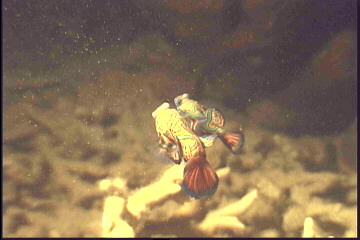 We got back to the
marine lab just before sunset. Several nights earlier,
Lisa had done a dive just off the end of the boat dock,
and had watch the spectacularly-colored Mandarin fish (Synchiropus
splendidus) courting and spawning in just a few feet
of water. We decided to try to capture their behavior on
video, so Lisa and I quickly got our gear back on and
jumped off the end of the dock. Five minutes before
sunset, seemingly out of nowhere, these colorful little
Mandarin fish emerged from the rubble and began their
ritual.
We got back to the
marine lab just before sunset. Several nights earlier,
Lisa had done a dive just off the end of the boat dock,
and had watch the spectacularly-colored Mandarin fish (Synchiropus
splendidus) courting and spawning in just a few feet
of water. We decided to try to capture their behavior on
video, so Lisa and I quickly got our gear back on and
jumped off the end of the dock. Five minutes before
sunset, seemingly out of nowhere, these colorful little
Mandarin fish emerged from the rubble and began their
ritual.
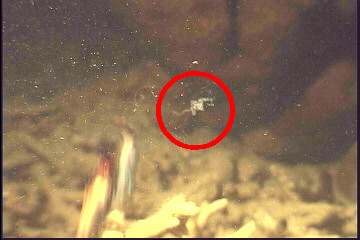 The larger male would
swim about with fins spread, enticing the smaller females
to spawn with him. Eventually, the male and one of the
females would "flutter" side-by-side and rise
from the rubble a few inches off the bottom. After
hovering in place for a few seconds (photo above), both
members of the pair would release their gametes (shown in
the red circle at right) and rush back to the reef (the
two fish can be seen in the lower left foreground of the
photo at right, rushing back to the rubble).
The larger male would
swim about with fins spread, enticing the smaller females
to spawn with him. Eventually, the male and one of the
females would "flutter" side-by-side and rise
from the rubble a few inches off the bottom. After
hovering in place for a few seconds (photo above), both
members of the pair would release their gametes (shown in
the red circle at right) and rush back to the reef (the
two fish can be seen in the lower left foreground of the
photo at right, rushing back to the rubble).
All in all, it was a wonderful and refreshing day. The trip is definitely winding down to a close at this point. John is leaving tomorrow to return to Honolulu. Pat, Ken, Lisa, Jack, Lori, Sara, and I plan one final dive for tomorrow morning, after which we will pack up in preparation for our departure the following morning.
